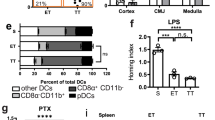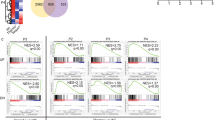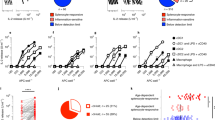Abstract
The molecular mechanisms that direct the migration of early T lymphocyte progenitors to the thymus are unknown. We show here that P-selectin is expressed by thymic endothelium and that lymphoid progenitors in bone marrow and thymus bind P-selectin. Parabiosis, competitive thymus reconstitution and short-term homing assays indicated that P-selectin and its ligand PSGL-1 are functionally important components of the thymic homing process. Accordingly, thymi of mice lacking PSGL-1 contained fewer early thymic progenitors and had increased empty niches for prothymocytes compared with wild-type mice. Furthermore, the number of resident thymic progenitors controls thymic expression of P-selectin, suggesting that regulation of P-selectin expression by a thymic 'niche occupancy sensor' may be used to direct progenitor access.
This is a preview of subscription content, access via your institution
Access options
Subscribe to this journal
Receive 12 print issues and online access
$209.00 per year
only $17.42 per issue
Buy this article
- Purchase on Springer Link
- Instant access to full article PDF
Prices may be subject to local taxes which are calculated during checkout







Similar content being viewed by others
References
Donskoy, E. & Goldschneider, I. Thymocytopoiesis is maintained by blood-borne precursors throughout postnatal life. A study in parabiotic mice. J. Immunol. 148, 1604–1612 (1992).
Blais, M.E. et al. Do thymically and strictly extrathymically developing T cells generate similar immune responses? Blood 103, 3102–3110 (2004).
Guy-Grand, D. et al. Extrathymic T cell lymphopoiesis: ontogeny and contribution to gut intraepithelial lymphocytes in athymic and euthymic mice. J. Exp. Med. 197, 333–341 (2003).
Lind, E.F., Prockop, S.E., Porritt, H.E. & Petrie, H.T. Mapping precursor movement through the postnatal thymus reveals specific microenvironments supporting defined stages of early lymphoid development. J. Exp. Med. 194, 127–134 (2001).
Petrie, H.T. Role of thymic organ structure and stromal composition in steady-state postnatal T cell production. Immunol. Rev. 189, 8–19 (2002).
Foss, D.L., Donskoy, E. & Goldschneider, I. The importation of hematogenous precursors by the thymus is a gated phenomenon in normal adult mice. J. Exp. Med. 193, 365–374 (2001).
Bhandoola, A., Sambandam, A., Allman, D., Meraz, A. & Schwarz, B. Early T lineage progenitors: new insights, but old questions remain. J. Immunol. 171, 5653–5658 (2003).
Martin, C.H. et al. Efficient thymic immigration of B220+ lymphoid-restricted bone marrow cells with T precursor potential. Nat. Immunol. 4, 866–873 (2003).
Allman, D. et al. Thymopoiesis independent of common lymphoid progenitors. Nat. Immunol. 4, 168–174 (2003).
Schwarz, B.A. & Bhandoola, A. Circulating hematopoietic progenitors with T lineage potential. Nat. Immunol. 5, 953–960 (2004).
Petrie, H.T. Cell migration and the control of post-natal T cell lymphopoiesis in the thymus. Nat. Rev. Immunol. 3, 859–866 (2003).
Campbell, D.J., Kim, C.H. & Butcher, E.C. Chemokines in the systemic organization of immunity. Immunol. Rev. 195, 58–71 (2003).
Campbell, J.J. & Butcher, E.C. Chemokines in tissue-specific and microenvironment-specific lymphocyte homing. Curr. Opin. Immunol. 12, 336–341 (2000).
Vestweber, D. & Blanks, J.E. Mechanisms that regulate the function of the selectins and their ligands. Physiol. Rev. 79, 181–213 (1999).
Lowe, J.B. Glycosylation in the control of selectin counter-receptor structure and function. Immunol. Rev. 186, 19–36 (2002).
Ley, K. & Kansas, G.S. Selectins in T cell recruitment to non-lymphoid tissues and sites of inflammation. Nat. Rev. Immunol. 4, 325–335 (2004).
Lowe, J.B. & Marth, J.D. A genetic approach to Mammalian glycan function. Annu. Rev. Biochem. 72, 643–691 (2003).
Ellies, L.G. et al. Core 2 oligosaccharide biosynthesis distinguishes between selectin ligands essential for leukocyte homing and inflammation. Immunity 9, 881–890 (1998).
Yang, J. et al. Targeted gene disruption demonstrates that P-selectin glycoprotein ligand 1 (PSGL-1) is required for P-selectin-mediated but not E-selectin-mediated neutrophil rolling and migration. J. Exp. Med. 190, 1769–1782 (1999).
Winkler, I.G., Snapp, K.R., Simmons, P.J. & Levesque, J.P. Adhesion to E-selectin promotes growth inhibition and apoptosis of human and murine hematopoietic progenitor cells independent of PSGL-1. Blood 103, 1685–1692 (2004).
Levesque, J.P. et al. PSGL-1-mediated adhesion of human hematopoietic progenitors to P-selectin results in suppression of hematopoiesis. Immunity 11, 369–378 (1999).
Rosen, S.D. Ligands for L-selectin: homing, inflammation, and beyond. Annu. Rev. Immunol. 22, 129–156 (2004).
Corbel, S.Y. et al. Contribution of hematopoietic stem cells to skeletal muscle. Nat. Med. 9, 1528–1532 (2003).
Kondo, M., Weissman, I.L. & Akashi, K. Identification of clonogenic common lymphoid progenitors in mouse bone marrow. Cell 91, 661–672 (1997).
Adolfsson, J. et al. Upregulation of Flt3 expression within the bone marrow Lin(−)Sca1(+)c-kit(+) stem cell compartment is accompanied by loss of self-renewal capacity. Immunity 15, 659–669 (2001).
Sitnicka, E. et al. Key role of flt3 ligand in regulation of the common lymphoid progenitor but not in maintenance of the hematopoietic stem cell pool. Immunity 17, 463–472 (2002).
Wright, D.E., Wagers, A.J., Gulati, A.P., Johnson, F.L. & Weissman, I.L. Physiological migration of hematopoietic stem and progenitor cells. Science 294, 1933–1936 (2001).
McEver, R.P. & Martin, M.N. A monoclonal antibody to a membrane glycoprotein binds only to activated platelets. J. Biol. Chem. 259, 9799–9804 (1984).
Mazo, I.B., Quackenbush, E.J., Lowe, J.B. & von Andrian, U.H. Total body irradiation causes profound changes in endothelial traffic molecules for hematopoietic progenitor cell recruitment to bone marrow. Blood 99, 4182–4191 (2002).
Prockop, S.E. & Petrie, H.T. Regulation of thymus size by competition for stromal niches among early T cell progenitors. J. Immunol. 173, 1604–1611 (2004).
Merzaban, J.S., Zuccolo, J., Corbel, S.Y., Williams, M.J. & Ziltener, H.J. An alternate core 2 β1,6-N-Acetylglucosaminyltransferase selectively contributes to P-selectin ligand formation in activated CD8 T cells. J. Immunol. 174, 4051–4059 (2005).
Almeida, A.R., Borghans, J.A. & Freitas, A.A. T cell homeostasis: thymus regeneration and peripheral T cell restoration in mice with a reduced fraction of competent precursors. J. Exp. Med. 194, 591–599 (2001).
Porritt, H.E. et al. Heterogeneity among DN1 prothymocytes reveals multiple progenitors with different capacities to generate T cell and non-T cell lineages. Immunity 20, 735–745 (2004).
Toothill, V.J., Van Mourik, J.A., Niewenhuis, H.K., Metzelaar, M.J. & Pearson, J.D. Characterization of the enhanced adhesion of neutrophil leukocytes to thrombin-stimulated endothelial cells. J. Immunol. 145, 283–291 (1990).
McEver, R.P., Beckstead, J.H., Moore, K.L., Marshall-Carlson, L. & Bainton, D.F. GMP-140, a platelet α-granule membrane protein, is also synthesized by vascular endothelial cells and is localized in Weibel-Palade bodies. J. Clin. Invest. 84, 92–99 (1989).
Schwientek, T. et al. Control of O-glycan branch formation. Molecular cloning and characterization of a novel thymus-associated core 2 β1, 6-n-acetylglucosaminyltransferase. J. Biol. Chem. 275, 11106–11113 (2000).
Yeh, J.C., Ong, E. & Fukuda, M. Molecular cloning and expression of a novel β-1, 6-N-acetylglucosaminyltransferase that forms core 2, core 4, and I branches. J. Biol. Chem. 274, 3215–3221 (1999).
Borges, E. et al. The binding of T cell-expressed P-selectin glycoprotein ligand-1 to E- and P-selectin is differentially regulated. J. Biol. Chem. 272, 28786–28792 (1997).
Abkowitz, J.L., Robinson, A.E., Kale, S., Long, M.W. & Chen, J. Mobilization of hematopoietic stem cells during homeostasis and after cytokine exposure. Blood 102, 1249–1253 (2003).
Petrie, H.T., Hugo, P., Scollay, R. & Shortman, K. Lineage relationships and developmental kinetics of immature thymocytes: CD3, CD4, and CD8 acquisition in vivo and in vitro . J. Exp. Med. 172, 1583–1588 (1990).
Lenter, M., Levinovitz, A., Isenmann, S. & Vestweber, D. Monospecific and common glycoprotein ligands for E- and P-selectin on myeloid cells. J. Cell Biol. 125, 471–481 (1994).
Pfaffl, M.W., Horgan, G.W. & Dempfle, L. Relative expression software tool (REST) for group-wise comparison and statistical analysis of relative expression results in real-time PCR. Nucleic Acids Res. 30, e36 (2002).
Acknowledgements
We thank J. Marth for the C2-deficient mice; R. Stokes for helpful discussions; K.M. McNagny, G. Aversa and P. Orchansky for critical evaluation of the manuscript; and A. Johnson for assistance with flow cytometry. J.S.M. is supported by a CIHR Transplantation Fellowship. F.M.V.R. is supported by the Canada Research Chairs Program and the Michael Smith Foundation for Health Research. This work was supported by Canadian Institute for Health Research grants to H.J.Z. and to F.M.V.R. and by Networks of Centres of Excellence–StemNet funding to F.M.V.R.
Author information
Authors and Affiliations
Corresponding authors
Ethics declarations
Competing interests
The authors declare no competing financial interests.
Supplementary information
Supplementary Fig. 1
Gating used for the identification of the different subpopulations analyzed in Figure 1. (PDF 897 kb)
Supplementary Fig. 2
PSGL-1-deficient cells are evenly distributed in wild-type thymi. (PDF 4440 kb)
Supplementary Fig. 3
Engraftment of wild-type and PSGL-1-deficient cells in IL-7R-deficient mice. (PDF 464 kb)
Supplementary Fig. 4
PSGL-1-deficient cells engraft with high efficiency in the thymus after intrathymic injection. (PDF 474 kb)
Supplementary Table 1
Summary of thymic chimerisms in parabiotic mice. (PDF 30 kb)
Supplementary Table 2
Competitive repopulation by intrathymic injection. (PDF 30 kb)
Rights and permissions
About this article
Cite this article
Rossi, F., Corbel, S., Merzaban, J. et al. Recruitment of adult thymic progenitors is regulated by P-selectin and its ligand PSGL-1. Nat Immunol 6, 626–634 (2005). https://doi.org/10.1038/ni1203
Received:
Accepted:
Published:
Issue Date:
DOI: https://doi.org/10.1038/ni1203
This article is cited by
-
OVOL2 sustains postnatal thymic epithelial cell identity
Nature Communications (2023)
-
Downregulation of chemokine receptor 9 facilitates CD4+CD8αα+ intraepithelial lymphocyte development
Nature Communications (2023)
-
Lymphotoxin: from the physiology to the regeneration of the thymic function
Cell Death & Differentiation (2021)
-
Panning for brain antigens in dural sinuses
Cell Research (2021)



